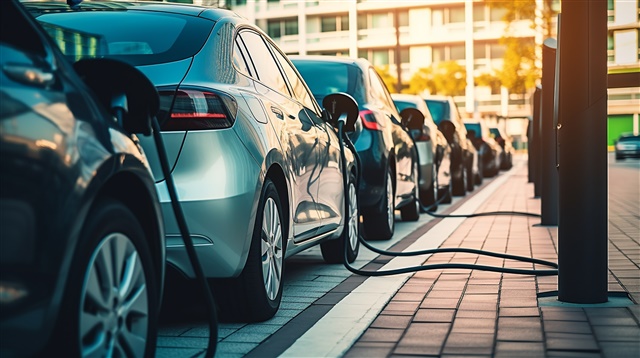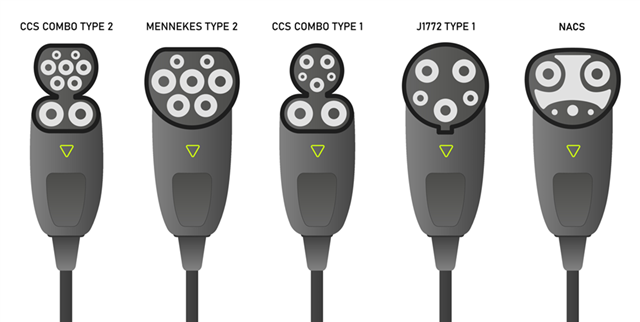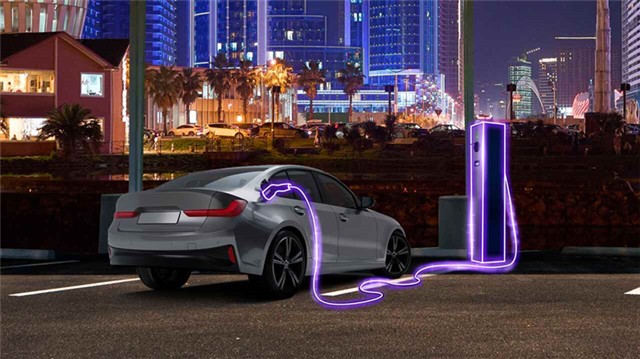SSZTD10 November 2023 AM625 , MSPM0C1105 , MSPM0C1106 , MSPM0G1106 , MSPM0G1107 , MSPM0G1506 , MSPM0G1507 , MSPM0G1518 , MSPM0G1519 , MSPM0G3106 , MSPM0G3106-Q1 , MSPM0G3107 , MSPM0G3107-Q1 , MSPM0G3506 , MSPM0G3506-Q1 , MSPM0G3507 , MSPM0G3507-Q1 , MSPM0G3518 , MSPM0G3518-Q1 , MSPM0G3519 , MSPM0G3519-Q1 , MSPM0H3216

Manufacturers of electric vehicle (EV) charging systems have two things on their mind: First, to design reliable charging systems that can operate for years to come; and second, to create a seamless, positive charging experience for consumers.
Organizations like the Charging Interface Initiative (CharIN), an industry association with over 330-member companies, are promoting interoperability standards in the field of charging systems for charging EVs of all types in many different countries. In addition to developing the Combined Charging System (CCS), which has been adopted by EV charger makers in several countries, CharIN has been steadily working on ways to standardize the North American Charging Standard (NACS) used by Tesla fast-charging stations in the U.S.
Earlier this year, I had a discussion with Erika Myers, Executive Director at CharIN North America, about her thoughts on the recent trend in NACS [North American Charging Standard] adoption by many automakers. According to Myers, “CharIN expects that the CCS standard and NACS/SAE J3400 will coexist as EV charging options for some time. Our view is that both standards have the potential to offer a seamless user experience, which is necessary to meet consumer demand for charging reliability. To achieve consistent interoperability in the charging ecosystem, industry collaboration will be vital to ensure a great user experience, all while reducing market complexity, eliminating consumer confusion, and accelerating EV adoption.”
As a member of CharIN, TI continues to work with our customers to simplify EV charging connectivity and their interoperability needs as standards evolve. But the fact remains that customers have many standards they need to meet, and building the entire system can feel overwhelming to even the most capable team of engineers. Let’s take a look at some of the factors impacting design decisions of EV charging manufacturers.
Connector types

Common types of EV charging connectors
Imagine you are driving an EV and you cannot connect to certain charging stations on a cross-country road trip. When you add range anxiety to the situation, which results from having a low charge on your EV’s battery, finding a compatible charging station before becoming stranded on the side of the road can rapidly escalate from stressful to frustrating. There is a chance that the next DC fast charging station on your journey may not be compatible with your EV, or the spot with the right connector is already in use by someone else.
One proposed way to solve this challenge is the NACS connector, which uses the same connector type for both AC and DC charging, with a smaller form factor than other standardized connectors. According to Janek Metzner at Pionix, “The dominoes [for NACS adoption] are falling into place faster than expected. If SAE officially standardizes the connector, [that] will facilitate an even faster adoption rate.” Pionix’s Linux-based open-source EVerest platform software stack, which is compatible with our AM625 processor, enables communication between the electric vehicle supply equipment (EVSE) and the vehicle.
While it may seem like Meyers and Metzner have different opinions, they are actually consistent. CharIN and Pionix are both founded on the premise of improving interoperability during the global migration toward EVs. At TI, we focus on creating the embedded processors and analog products that help designers create the applications that enable the transition to more renewable energy sources, efficient EV charging and a more efficient, smarter grid. The connector type is largely irrelevant as long as both sides – charging station and vehicle – are physically compatible and communicate in the same way. Table 1 below breaks out the various connector types and definitions.
| Connector types | Definition |
|---|---|
| SAE J1772 | The electromechanical connector standard credited to the Society for Automotive Engineers (SAE) for AC electric vehicle service equipment (EVSE), commonly found in North America. Also known as a Type 1 connector. |
| Type 2 connector | The European equivalent to Type 1. Also known as Mennekes or IEC 62196-2. |
| CCS1, CCS2 | The DC charging extensions of Type 1 and Type 2 connectors, with larger DC ± pins added underneath the pins used for communication and AC power. |
| NACS | North American Charging Standard, or the “Tesla” connector, a connector type currently being defined and standardized as SAE J3400. |
Analog handshake
In the world of electronics, a “handshake” describes an agreement between two integrated circuits that need to work together in a system. While the handshake can occur between two ICs on the same circuit board, it is easier to comprehend when there is a cable in between two systems. Thankfully, an EV charging station and a vehicle are always connected by a relatively long cable, so you can visualize the two systems shaking hands when the cable plug is inserted into the receptacle and an electrical connection is made.
The key concepts to the handshake involved in EV charging are generating a voltage on one side and terminating it with a resistor on the other to reduce the voltage to a specific level. Because everyone uses the same voltage and the same pre-defined resistor values, this handshake always produces the same results unless a fault condition is present, and a decision is made to either continue with basic charging or move on to a more involved negotiation called high-level charging.

While basic charging is simple from a communications perspective, the circuitry required to open or close relays and detect fault conditions can be quite complex. The AC level 2 charger platform reference design is a design that can be used to start implementing many of the functional blocks in a typical EV supply equipment (EVSE) system. For many basic chargers, a small microcontroller such as MSPM0G3507 may be sufficient. However, when both the charging station and EV support high-level charging, they agree to switch to digital communication and an Arm-based processor running embedded Linux is almost always required. Table 2 highlights the various analog handshake options in a charging system.
| Analog handshake | Definition |
|---|---|
| Proximity pilot (PP) | The signal used by a vehicle to determine when it is connected to a charging station (in North America). In Europe, this signal is alternatively used by the charging station to determine the current capacity of the charging cable. |
| Control pilot (CP) | The signal used by a charging station to determine when a vehicle is connected to it. |
| IEC 61581 | International Electrotechnical Commission 61851, or the standard most commonly associated with simple AC charging through a wall box, which typically takes place at the home of an EV owner. Also known as basic charging. |
Digital communication – language and dialects
Simply because two people speak the same language does not mean that they will understand each other’s regional dialect, accent or slang. The ISO 15118 standard is the common language of EVs and charging stations, while specific brands tend to use slang that could easily be misinterpreted easily if your charging station is not familiar with that brand of EV.
Consumer adoption of EVs is greatly impacted by the user experience, and a common language for digital communication across the EV charging infrastructure is necessary to increase the rate of adoption. In addition to working with CharIN, we collaborate with Pionix to provide its open-source EV charging software stacks to customers with the goal of resolving the most complex challenge facing the EV charging industry today: fully tested, standard-compliant digital communications compatible with nearly every EV on the market. Table 3 lists the various digital communications options tied to EV charging systems.
| Digital communication | Definition |
|---|---|
| ISO 15118 | International Organization for Standardization 15118, a communication protocol that enables the use of advanced features in a charging session, such as DC charging, plug and charge, and bidirectional charging. Also known as high-level charging. |
| DIN SPEC 70121 | Deutsches Institut für Normung 70121, a specification that was the predecessor to ISO 15118, sometimes used interchangeably with ISO 15118. |
| PLC PHY | Programmable logic controller physical layer, a specific type of integrated circuit used for communication between EVs and charging stations that must be present on both sides for high-level charging. Also known as HomePlug GreenPHY. |
Our AM625-based EVSE development platform was created to demonstrate and support all standard-compliant digital communications and show the scalability of the AM625 processor family for any EV charging application.
Smart, connected EV charging station development platform
Smart, connected EV charging station development platform based on AM625 with HMI
A seamless charging experience
It is possible to resolve the issues of physical connector compatibility by providing adapters and installing stations with different plug types, although a common connector could potentially simplify the EV charging experience. The analog handshake is foundational, but it is also basic (pun intended). Creating a standardized charging infrastructure that is easy to use will require every charging station to speak the same language and dialect as any EV that is connected to it. Our goal as a semiconductor manufacturer is the same as our EV charging manufacturer customers around the world: to continue to design and develop the technology that solves the interoperability issues, and ultimately provide a seamless charging experience for all EV drivers.
Additional resources:
- Check out the Smart, connected EV charging station development platform based on AM625 with HMI
- Learn more about TI’s solutions for EV charging: ti.com/evcharging